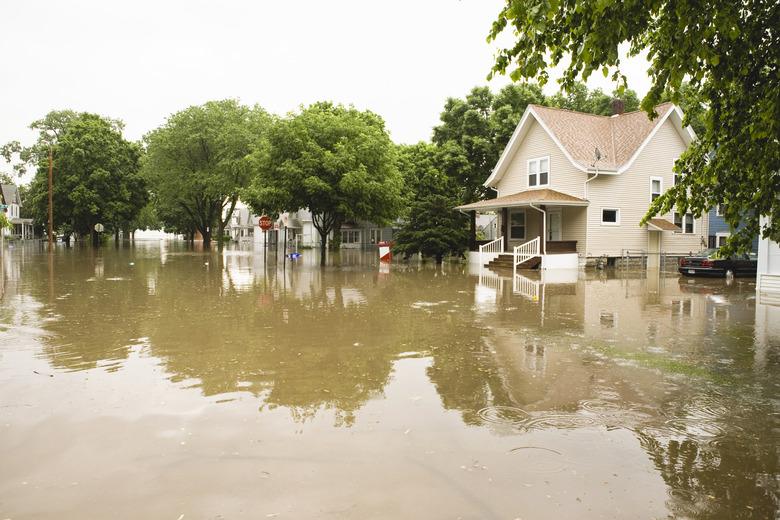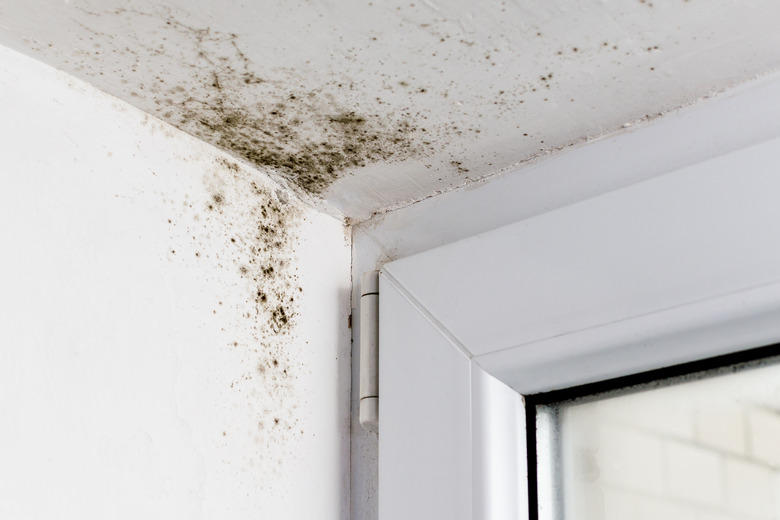How Does A Flood Damage A House?
We may receive a commission on purchases made from links.
A typical homeowners' insurance policy covers your property for water damage but not for flood damage — and if you didn't know they were different, you're not alone. But even homeowners who do know the difference are often reluctant to take out a flood insurance policy because they figure the likelihood of a flood is small, but according to the Federal Emergency Management Agency (FEMA), flood damage is common, with over 100 major flood events occurring annually in half of the last 25 years and 99 percent of United States counties experiencing at least one flood during that period. The National Flood Insurance Program (NFIP) reports that homes in high-risk areas stand a one in four chance of sustaining flood damage during the course of a 30-year mortgage.
Unlike a wildfire or an earthquake, a flood doesn't always appear catastrophic as it develops unless it's part of another cataclysmic event, such as a hurricane. Water can rise almost secretly, and the danger may not be immediately apparent, but the resulting damage is often far worse than a homeowner may expect. Water is the giver of life — not just for humans but for myriad microscopic organisms that cause disease, and they thrive in the aftermath of a flood. Dirty water is also an excellent conductor of electricity, and electrical fires and electrocution are very real possibilities in the aftermath of a flood.
At an average cost of around $700 a year, a flood insurance policy is a good investment for any homeowner, and mortgage companies usually require it before financing any property in a flood zone. Because of the extensive damage a flood can cause, cleanup is expensive and takes a long time, and for much of that time, the home is basically uninhabitable. A flood can also damage vital infrastructure outside the home, and if a major flood occurs, you can't expect much help from the neighbors because the damage is widespread, and they'll be coping with the same situation.
Tip
A flood can cause damage to a house's structure and electrical, plumbing and HVAC systems, and the mold that inevitably grows afterward forces the removal of water-damaged drywall, insulation and sometimes wood framing.
Flood Damage vs. Water Damage
Flood Damage vs. Water Damage
Most homeowners' insurance policies cover water damage, and that's one of the main reasons homeowners purchase it. Read the fine print, however, and you'll probably find that you're on your own in the event of a flood. Obviously, flood damage is caused by water, but insurance companies consider flood damage and water damage to be two different things, and the difference isn't always clear. A prolonged roof leak that results in standing water in the attic could be considered a flood by the insurance company that issued your homeowners' policy. Conversely, if you have flood insurance, the company that issued it might consider it water damage.
By most definitions, a flood is caused by water that originated in a natural disaster, such as a hurricane, a period of heavy rain or some other event, while water damage is caused by a relatively minor event, such as a plumbing leak or an overflowing washing machine. The NFIP defines a flood as partial or complete inundation of two or more acres of normally dry land or two or more properties, one of which belongs to the policyholder. According to that definition, any damage from a plumbing or roof leak or an overflowing washing machine that results in standing water would not be considered flood damage, but it's a gray area that should be clarified with your insurance company.
A Flood Causes Structural Damage
A Flood Causes Structural Damage
When a flood happens quickly, such as a flash flood, the sheer force of the moving water can damage your home's foundation, siding and walls. The structural damage becomes worse the longer standing water stays inside the building since wood and drywall become increasingly compromised, and even after the floodwaters recede, the wood remains waterlogged for a long time unless special efforts are made to dry it. All drywall in contact with the water has to be replaced, and some of the wood may also have to be replaced.
Even floodwaters that don't actually rise above the surface of the ground can damage a building's foundation by creating hydrostatic pressure strong enough to crack the foundation. The potential for damage increases the longer the groundwater level stays abnormally high. The pressure can be great enough to lift concrete pad foundations as well as outdoor patios and walkways, and it can undermine footings for post-and-beam foundations and deck posts, crack swimming pools and damage fences, outbuildings and utility poles.
Electrical Damage in a Flood
Electrical Damage in a Flood
While pure water is a poor conductor of electricity, floodwater is full of electrolytes that turn it into a good electrical conductor. This makes it dangerous to return to your house after a flood without electrically insulated gear unless the utility company has turned off the power (which it usually has). Saltwater is particularly dangerous, but all floodwater contains dissolved ions, and besides creating an electrocution hazard, they corrode any electrical equipment with which the water comes in contact. Electrical receptacles, switches and breaker panels are all susceptible, and even after they dry, they may cause arcing (essentially an uncontrollable electrical current that can injure someone) when power is restored, so they usually have to be replaced after immersion in floodwater.
Appliances and HVAC Equipment
Appliances and HVAC Equipment
Electric appliances and HVAC components are as susceptible to corrosion as the home's electrical system and should never be operated until they have been inspected by an electrician or HVAC pro. Many contain sensitive electronic controls that probably won't work anyway after being immersed in water, but those that do still operate may overheat or cause arcing. In most cases, it's best to throw out flood-damaged appliances and HVAC equipment and replace them, but in some cases, such as the furnace or central air system, it may be more practical to repair them if possible.
Gas appliances that aren't susceptible to electrical damage can often be salvaged, but they pose a different hazard. When the house floods, they might move around, and if the movement results in a broken or burst pipe, there's a risk of explosion. If the power is still on, this is another reason to avoid turning on any light switches, and you should avoid using lighters or other open flames when returning to your house for the first time. If it's dark, use a bright flashlight or headlamp to help you see. Because the water heater is full of water and is usually in the basement or on the first floor, it's the appliance of which to be most wary.
Mold Growth After a Flood
Mold Growth After a Flood
Among the most pernicious consequences of a flood, mildew and mold growth take time to develop into a problem but not much time because visible colonies can appear 24 to 48 hours after the floodwater subsides and surfaces are exposed to the air. If left unchecked, the colonies fill the air with spores and cause allergic reactions. Professional cleanup of mold is almost always required. The Environmental Protection Agency limit for DIY cleanup is 10 square feet, and after a flood, there is certain to be more growth than that. (Also, it's uncommon for flood insurance to cover self-cleanup.)
Dehumidifiers and fans have to be deployed to dry the house as thoroughly as possible to prevent further damage. Contaminated wallboard, carpeting, insulation and upholstered furniture has to be discarded, baseboards have to be removed for cleaning or discarded and nonporous surfaces have to be disinfected with a bleach solution or a bleach substitute. Mold often has to be physically removed from porous surfaces, such as wood, tile and concrete, using soap and water because bleach has a high surface tension that prevents it from soaking into the pores and killing the roots of the spores. The cleanup is complicated by contaminants in any raw sewage that flowed into the house.
With the power off, the refrigerator no longer cools, so the food inside it also goes moldy and has to be discarded. If the floodwater was high enough to contact the refrigerator insulation, it also has to be discarded. Otherwise, it needs to be cleaned and disinfected.
Flood Damage to Plumbing and Septic Systems
Flood Damage to Plumbing and Septic Systems
Sometimes, leaking or damaged plumbing fixtures are the cause of flooding, and it goes without saying that those fixtures need to be repaired or replaced. Fixtures that were immersed in floodwater but are still working can be salvaged, but they may have to be disassembled and disinfected to kill mold. Plumbing drains that back up in a flood often return to normal after the water recedes, but one or more may be blocked by contaminants in the floodwater and need to be cleaned. The hydrostatic pressure of a flood can break underground water and waste pipes, and it usually takes a professional to locate the breaks and repair them.
A septic system can suffer serious damage during a flood, but more often than not, it's the drainage field and not the tank that suffers the damage. The tank is sealed and underground, and although it can fill with silt and need to be pumped, there's an equal chance that it won't. If the floodwaters deposit enough silt on the drainage field to block it, however, the only solution is to move the drainage field to another location. That's a big, expensive deal, and you'll know it's necessary if standing water remains on the field after the floodwaters recede, and you can smell sewage odors.
Emotional and Economic Damage
Emotional and Economic Damage
Flood damage includes more than just the physical damage to your property. Emotional damage is inevitable, and it can be long-lasting, considering that it often takes years to restore life to an even keel after a major disaster. People feel anxiety, fear, depression and even anger, and it colors personal relationships and spiritual outlook, and these feelings can make doing the necessary cleanup work even more difficult. It's for this reason that organizations that respond to disaster, including FEMA and the Red Cross, routinely include mental health professionals in their response teams.
Loss of life is a real possibility during a major flood, and those left behind have to cope. If you don't include disasters like China's Great Famine, which was preventable, floods like the 1931 Yangtze River flood have been responsible for more deaths than any other type of natural disaster. In the United States, flash floods are the top weather-related killer, claiming the lives of people and animals alike.
On top of it all, a major disaster can impose crippling financial burdens on people affected by it, especially in the absence of appropriate insurance coverage. Flooding caused $8.5 billion in property damage in the United States in 2011 alone, and government assistance programs can't offset everyone's personal losses. The good news is that there's an easy way to prevent financial ruin, and that's to budget for flood insurance so you can clean up and rebuild rather than being forced to sell what's left of your property and move.
References
- Federal Emergency Management Agency: Historical Flood Risk and Costs
- Total Restoration of Texas: Water Damage vs Flood Damage: What's the Difference?
- NCMIC: Flood Damage vs Water Damage: Know the Difference
- Water Damage Defense: Floods & Structural Damage
- Consumer Reports: What to Know About Water-Damaged Appliances
- Rainbow International Restoration: 5 Ways Flood Damage Can Affect Your Home or Business

